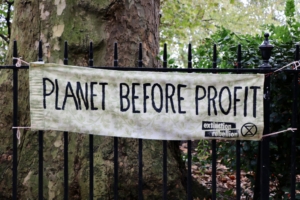The Rise of Antifa, a Federalist Answer on Immigration, and Replacing Leslie Knope
Here’s What You Need To Know
In April 2016, the Department of Homeland Security and the FBI issued a confidential joint intelligence assessment labeling a leftist extremist group named Antifa – short for anti-fascists – as “domestic terrorists,” predicting they would engage in violence with radical right-wing organizations.
A few weeks ago, this group finally began to capture the public’s attention as fights broke out between Antifa and white supremacists in Charlottesville. However, even before this incident, Antifa protestors have repeatedly engaged in violent behavior over the past several years in places like Berkeley, Washington D.C., New Orleans, Portland, Chicago, and Philadelphia. This has included beating innocent people, attacking police with clubs, setting cars on fire, smashing windows, and other destructive activity.
In the wake of this violence, there’s been much discussion and debate in the media about what Antifa is and how serious of a threat they pose. So, we want to give a clear, factual view of their history, how they operate, what they believe, who is funding them, and why they are becoming a more significant threat:
Subscribe to Receive Insights
"*" indicates required fields
- Where Did They Come From? Antifa can be traced back to an alliance of German Communists and Social Democrats that was founded against Nazism during the Third Reich. In the 1980’s, drawing on this legacy, a loose collection of groups called the Anti-Fascist Action (AFA) was formed in Britain to often violently oppose far-right wing movements. This activity inspired left-wing punk fans in the United States to follow suit by creating their own anti-fascist groups.
- What Do They Believe? Antifa is primarily comprised of communists, socialists and anarchists. However, their common cause appears to be sowing chaos, attacking police, and shutting down speech from people they disagree with. One Antifa group in Washington advocates for acts of vandalism just to make middle class people “feel a little less safe,” while another in Philadelphia holds workshops called “Our Enemies in Blue,” which celebrate violence against police. Antifa claims they are working to stop fascists and white supremacists, but they often go after events that clearly do not fall into that category, including San Francisco’s “Liberty Weekend,” which was organized by an Asian American and explicitly forbade extreme elements from joining.
- How Are They Organized? The movement is largely decentralized, and represents more of an amalgamation of loosely affiliated groups throughout the country than any single, unified organization. However, particularly on the West Coast, there are some local bodies, such as Rose City Antifa in Portland, that are more well-organized and active online.
- Who Is Funding Them? One significant player funding Antifa elements is George Soros, the world’s wealthiest hedge fund manager and a major donor to Democratic and leftist causes. Soros played key roles in crashing the British pound during “Black Wednesday” in 1992 and the Thai Baht during the 1997 and 1998 Asian Financial Crisis.
- What Is Different Now? The growth of Antifa coincides with growing support from many, especially younger people, for shutting down speech they determine to be hateful or otherwise unacceptable. A 2015 Pew Research poll found 40 percent of Millennials support limiting free speech that is offensive to minorities, although this strain of thought often extends to more mainstream individuals engaging in reasonable debate. This attitude is especially evident on college campuses where protestors have shut down speaking engagements from conservative speakers like Charles Murray and Condoleezza Rice. In addition, the perception among many on the left that Trump supports fascists has also fueled the surge in Antifa activity. In the three weeks before Trump was inaugurated, NYC Antifa’s Twitter following nearly quadrupled.
Given their growing prominence, Antifa members and those emulating their tactics are likely to be a factor in protests for years to come. As a result, it’s important to separate myths from facts when it comes to analyzing the history, behavior, and activities of these types of extremist groups. Once they are understood, it’s possible to better identify when protest movements may be evolving into something more dangerous.
News You Can Use
JOURNALISTS’ TWITTER BUBBLE?
Many have argued that the rise of news consumption through social media is increasingly creating distinct ideological echo chambers across the political spectrum. Yet, this change may not only impact which news the public hears about, but also how news is shaped in the first place. Data scientists at the University of Northeastern recently analyzed the Twitter accounts of 1,000 journalists, finding a correlation between the political leanings of the people these journalists follow on Twitter and the ideological bent of the news content they produce.
It is unclear to what extent the journalists’ choices on who to follow on Twitter are changing the nature of their news coverage or simply reflect their pre-existing biases. However, this study shows that even journalists often become caught in echo chambers, and those seeking to influence journalists must understand how to break through these news bubbles.
IS FEDERALISM THE ANSWER FOR IMMIGRATION POLICY?
Immigration has long been seen as an issue over which only the federal government has jurisdiction over, but a new proposal seeks to delegate parts of this authority to the states. U.S. Senator Ron Johnson (R-WI) recently introduced the “State-Sponsored Visa Pilot Program Act,” which would allow for around 500,000 foreign guest worker visas to be managed and doled out by states, allotting at least 5,000 visas per state with the rest divided up by population. States would also be given the discretion to determine the skill levels or industries that would be eligible.
This flexibility would allow states like Wisconsin (where thousands of manufacturing jobs remain unfilled) and California (where millions in crops have gone unharvested due to the lack of workers) to fill labor shortages; states with higher unemployment rates could opt out of the program. In addition, it could defuse some of the divisive nature of immigration by letting red states and blue states choose their own approach. As a result, Johnson’s bill could be a way to help close the gap between Democrats who support expanding immigration and Republicans who favor states’ rights.
THE THREAT OF GREEN TERRORISM
Jamie Bartlett – a journalist whose focus is how technology impacts terrorism and radical political movements – claims terrorism from the environmental left is the next major threat. Although militant environmentalism is nothing new, Bartlett argues these “green” activists are increasingly turning to illegal and violent tactics due to a rising grievance culture and frustration with what they deem as the ineffectiveness of peaceful methods.
Bartlett provides tangible evidence to this trend, pointing to the violent activity on display during the Dakota Access pipeline (DAPL) protests, a recent terrorist attack on civilians by a radical environmentalist group in Brazil, and a report from the Department of Homeland Security warning of the potential for more attacks on energy infrastructure.
During the DAPL standoff, we at Delve saw this rising problem firsthand when we had the opportunity to help North Dakota law enforcement push back against false claims of police malpractice and reveal the attacks on people and property from many of the protesters. As we did in North Dakota, it is critical to monitor activists and anticipate their actions to protect people and assets in the energy industry and beyond.
WILL CHATBOTS REPLACE LESLIE KNOPE?
A great deal of socioeconomic debate in recent years has centered on the impact of automation on private sector employment. However, because government often lags behind, there has been less discussion on how technological developments could affect public sector jobs.
In recent months, cities like Kansas City, North Charleston, and Los Angeles have begun installing automated chat platforms or chatbots to guide residents through the process of requesting or accessing public services online, reducing costs and improving accessibility of services and information for taxpayers. Kansas City is even using a Facebook chatbot to answer questions on how to navigate its open data portal. Just as taxi cab drivers fought car sharing services in several cities, will public sector unions fight against adoption of these types of technologies that threaten their membership?
FREE SPEECH V. PROPERTY RIGHTS ON SOCIAL MEDIA
A legal battle between LinkedIn and a data mining start-up called hiQ could have major ramifications for what is considered public on social media. HiQ built its business around scrapping data from public LinkedIn profiles, but in June the networking site sent them a cease-and-desist letter demanding they stop this activity. The letter argued hiQ was violating the Computer Fraud and Abuse Act (CFAA), which was passed in the 1980s to criminalize hacking. In response, hiQ sued LinkedIn, asserting the right to access public profile data is protected by the First Amendment.
Last week, a U.S. District Judge issued an injunction in favor of hiQ. But the ruling did not address whether their activities constituted copyright or trespassing under the CFAA, and the case is likely to continue to higher courts. Regardless of the case’s outcome, it highlights how outdated many of the laws governing the internet are and how difficult it is for companies to navigate them to ensure they are engaging in lawful practices.
I’LL TAKE A LOAN WITH MY RIDE
Consumers in countries without reliable banks and financial institutions are now finding these services through an unlikely source: ride-sharing companies. As many as 2 billion people throughout the world lack access to traditional financial services. Many of these same people in countries like Kenya and Indonesia increasingly have access to smartphones, though, and use ride-sharing platforms.
As a result, many ride-sharing companies in these countries, such as South East Asia’s Grab, have seized on this opportunity by allowing their customers and drivers to use the app as an “e-wallet” to pay restaurants, retail establishments, and other vendors. This trend follows other tech companies like Ali-Baba and WeChat using their platforms to become the dominant payment processors in China. If tech companies are successful with dual- or multi-use features of their platforms in the developing world, look for them to seek opportunities to complete in developed countries in the long term.



